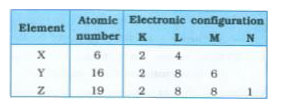There are three elements X, Y and Z having atomic numbers of 6, 16 and 19 respectively. Based on this information, Het has been asked to answer the following questions:
What will be the formula of ionic compound formed ?
In order to answer these questions, Het first wrote down the electronic configurations of the elements X, Y and Z by using their atomic numbers, as follows:

(3) The element Z has 1 valence electron, so its valency is +1 (after losing this electron). The element Y need two electrons to complete its octet. So, element Y will gain two electrons and form Y2− ion. Here, two Z+ ions will combine with one Y2− ion, so that the formula of ionic compound formed will be Z2Y.
Topper's Solved these Questions
- PERIODIC CLASSIFICATION OF ELEMENTSBOOK - KUMAR PRAKASHANCHAPTER - PERIODIC CLASSIFICATION OF ELEMENTSEXERCISE - Practical Skill Based Questions With Answers
2 Videos
- PERIODIC CLASSIFICATION OF ELEMENTSBOOK - KUMAR PRAKASHANCHAPTER - PERIODIC CLASSIFICATION OF ELEMENTSEXERCISE - Acitivity 5.2
2 Videos
- PERIODIC CLASSIFICATION OF ELEMENTSBOOK - KUMAR PRAKASHANCHAPTER - PERIODIC CLASSIFICATION OF ELEMENTSEXERCISE - OBJECTIVE QUESTIONS AND ANSWERS ((C ) )
1 Videos
- MODEL QUESTION PAPER 01BOOK - KUMAR PRAKASHANCHAPTER - MODEL QUESTION PAPER 01EXERCISE - (SECTION-A) (MCQs)
1 Videos
- QUESTION PAPER-2 (MARCH,2020 - BOARD'S QUESTIONS PAPER)BOOK - KUMAR PRAKASHANCHAPTER - QUESTION PAPER-2 (MARCH,2020 - BOARD'S QUESTIONS PAPER)EXERCISE - Section - D (Answer the following questions)
3 Videos
Similar Questions
Three are three elements X,Y and Z having atomiv numbers of 6,16 and 19 respectively. Based on this information, Rakshit has been asked to answer the following questions:
(a) In which group of the periodic table would you expect to find (i) element X (ii) element Y and (iii)( element Z?
(b) Which two elements will form ionic bonds ? Why?
(c) What will be the formula of ionic compound formed ?
(d) Which two elements will form covalent bonds? Why?
(e) What will be the formula of covalent compound formed?
(f) What values are displayed by Rakshit in answering the above questions?
View SolutionElements X, Y and Z have atomic numbers 6, 9 and 12 respectively. Which one :
forms a cation
View Solution
Knowledge Check
Three elements X , Y and Z have atomic numbers 19 , 37 and 55 respectively . Then the correct statement (s) is / are
ATheir ionization potential would increase with increasing atomic number.BY would have an ionization potential between those of X and Z.CZ would have the highest ionization potential.DY would have the highest ionization potential.Three elements X , Y and Z have atomic numbers 19 , 37 and 55 respectively . Then the correct statements (s) is / are
ATheir ionisation potential would increase with increasing atomic numbersBY would have an ionisation potential between those X and YCY would have the highest ionisation potentialDZ would have the highest ionisation potential
Elements X, Y and Z have atomic numbers 6, 9 and 12 respectively. Which one :
forms an anion
View SolutionThree elements X, Y and Z have atomic numbers 7, 8 and 9 respectively.
Write the formula of compound formed between
X and Z
View SolutionThree elements X, Y and Z have atomic numbers 7, 8 and 9 respectively.
Write the formula of compound formed between
X and Y
View SolutionElements X, Y and Z have atomic numbers 6, 9 and 12 respectively. Which one :
has four electrons in the valency shell ?
View SolutionThree elements X, Y and Z have atomic numbers 7, 8 and 9 respectively.
Which of the three is most electronegative ? Why?
View SolutionThere are three elements X, Y and Z. Their atomic numbers are 11, 18 and 19 respectively. Amongst X, Y and Z:
Which elements belong to the same period?
View Solution
